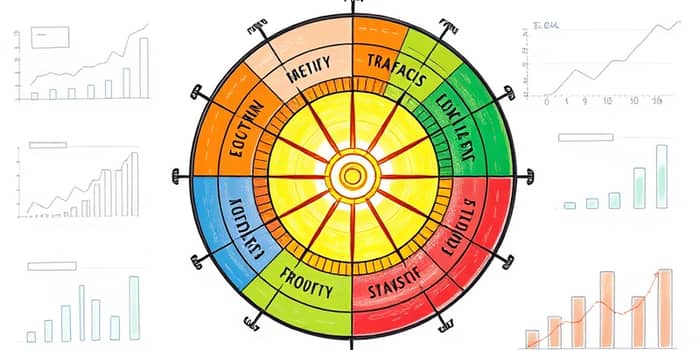
In an ever-shifting economic landscape, investors seek strategies that adapt to change rather than chase past performance. dynamic tactical investment strategy offers a methodical way to position capital where it can flourish under prevailing conditions. By shifting allocations between industry groups, this approach aims to harness the full power of cyclical trends and mitigate downside risk when conditions turn unfavorable.
This article provides a comprehensive roadmap for instituting a successful sector rotation plan. We will explore the underlying concepts, identify key signals, analyze historical patterns, and present actionable steps to integrate rotation into your portfolio. Prepare to engage with a strategy that transforms macroeconomic insights into concrete investment decisions.
Sector rotation is a strategy of shifting assets between economic sectors based on forecasts of relative performance tied to business cycles. Unlike passive buy-and-hold tactics, rotation requires active review, disciplined timing, and conviction that specific industries will lead or lag as economic phases evolve.
Sectors are groupings of companies sharing similar output, demand drivers, and sensitivity to macro factors. By identifying which segments will thrive in early expansion or those that excel in defensive recessions, investors can tilt their exposure toward areas with the greatest potential. This method elevates sector thinking above individual stock picking, fostering diversified and systematic portfolio management.
Implementing rotation demands a clear framework. Investors must define phases of the economic cycle, select a consistent indicator set, and adopt rules for rebalancing. Over time, this structured process can improve outcomes by capitalizing on predictable shifts in leadership rather than reacting impulsively to market noise.
Economic cycles typically progress through four stages—expansion, peak, contraction, and trough—each favoring distinct sectors. Understanding this progression is critical for anticipating turning points and positioning accordingly.
During expansions, cyclical areas like technology and discretionary spending typically lead as earnings grow and confidence rises. As the cycle matures, inflationary pressures boost energy and materials. Finally, in downturns, staples and healthcare provide a safe harbor against market turbulence.
There are several methodologies for executing rotations, each rooted in different data and timing paradigms. Selecting the right mix depends on your risk tolerance, time horizon, and analytical resources.
One common tactic is an economic indicators-based rotation model. Here, investors monitor GDP growth, interest rates, and inflation to infer the cycle stage and rebalance toward predicted winners. This top-down style aligns quickly with shifts in policy and macro trends.
In contrast, momentum-based approaches track recent relative strength among sector indices. When a segment shows sustained price outperformance, allocations tilt in its favor. While this method can capture vigorous trends, it may lag at precise turning points if momentum signals arrive late.
Fundamental-driven rotation evaluates earnings growth, valuations, and balance sheet health to target sectors trading at attractive multiples. Contrarian investors might also integrate out-of-favor sector rebound opportunities, buying areas that have underperformed but exhibit improving fundamentals as the cycle turns.
Macro signals serve as the compass for rotation decisions. By closely following these indicators, investors gain foresight into shifting sector dynamics and can adjust exposures systematically.
Combining these data points in a weighted model can produce a composite indicator, reducing the chance of false signals. Over time, backtesting helps validate which combinations best forecast sector leadership transitions.
Building a rotational portfolio begins with a baseline sector allocation—often a neutral weighting across all eleven sector ETFs. From there, monthly or quarterly reviews allow for incremental shifts based on the adopted rotation model.
Consider a scenario where rising inflation and commodity prices signal a late-cycle environment. An investor might reduce technology and consumer discretionary by 10–15%, redeploying that capital into energy and materials. Conversely, in early cycle, one would increase exposure to financials and discretionary firms benefiting from credit expansion.
A systematic approach prevents emotional overreactions and provides transparency. Tracking the performance differential between rotated and static portfolios can illustrate the value added over multiple cycles.
Historically, successful rotation during the early 2000s saw technology and consumer discretionary surge as the dot-com era advanced. Investors positioned in these sectors captured outsized gains before reallocating toward energy and materials in the mid-2000s commodity boom.
On the flip side, overly aggressive rotations can backfire. During the 2008 crisis, some momentum-based models failed to exit financials until after steep declines, while fundamental models that identified credit risks moved earlier into defensive sectors, preserving capital.
Despite its appeal, rotation is not a panacea. It requires rigorous monitoring and disciplined rebalancing to avoid sector whipsaws and costly timing errors. Transaction costs and tax consequences can erode gains if not managed carefully.
Moreover, unforeseen events—policy shocks, geopolitical crises, or black swan occurrences—can disrupt cycle patterns, rendering historical relationships less predictive. Investors must remain flexible, open to adjusting or pausing rotation when indicators conflict or volatility spikes.
Ultimately, sector rotation is a powerful tool in an active investor’s toolkit. By combining a clear process with vigilant risk management, practitioners can strive to capture value from economic shifts while limiting exposure to downturns. Embrace the discipline and let macro trends guide your next portfolio move.
References













